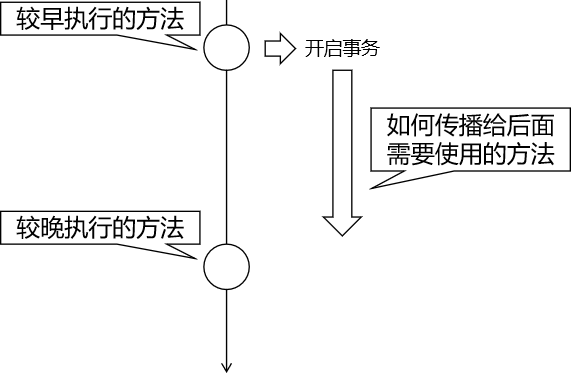第五章 Spring声明式事务
一 声明式事务概念
1.1 编程式事务
手动编写程序来管理事务,即通过编写代码的方式来实现事务的提交,和回滚。
1.2 声明式事务
声明式事务是指使用注解或配置文件来控制事务的提交和回滚。
开发者只需要添加注解或者配置文件,具体的实现通过框架来实现。
使用声明式事务可以将事务的控制和业务逻辑区分开,提高代码的可读性和课维护性.
1.3Spring事务管理器
-
Spring声明式事务对应依赖
- spring-tx: 包含声明式事务实现的基本规范(事务管理器规范接口和事务增强等等)
- spring-jdbc: 包含DataSource方式事务管理器实现类DataSourceTransactionManager
- spring-orm: 包含其他持久层框架的事务管理器实现类例如:Hibernate/Jpa等
-
Spring声明式事务对应事务管理器接口

我们现在要使用的事务管理器是org.springframework.jdbc.datasource.DataSourceTransactionManager,将来整合 JDBC方式、JdbcTemplate方式、Mybatis方式的事务实现!
DataSourceTransactionManager类中的主要方法:
- doBegin():开启事务
- doSuspend():挂起事务
- doResume():恢复挂起的事务
- doCommit():提交事务
- doRollback():回滚事务
1.4 Spring-tx
Spring-tx声明式事务的实现。
spring-tx提供了事务管理器的接口,但是没有实现类。没有实现类的原因是,对数据库操作的技术有很多如jdbc,dbutils,jdbcTemplate,mybatis,hibernate等。不同技术对应的事务方法也不一样。spring就没有提供实现类。
但是在其他包中有事务管理器的接口,根据对数据库操作使用的技术,来选择合适的实现类。
如spring-jdb包中的DataSourceTM 类是连接形事务,如jdbc,jdbcTemplate ,mybatis。
作为声明式事务,我们需要做的事情。一选择合适的事务管理器接口的实现类,二选择要事务管理的方法。

1.5 搭建环境
dao层
@Repository
public class StudentDao {@Autowiredprivate JdbcTemplate jdbcTemplate;public void updateNameById(String name,Integer id){String sql = "update students set name = ? where id = ? ;";int rows = jdbcTemplate.update(sql, name, id);}public void updateAgeById(Integer age,Integer id){String sql = "update students set age = ? where id = ? ;";jdbcTemplate.update(sql,age,id);}
}
service层
@Service
public class StudentService {@Autowiredprivate StudentDao studentDao;public void changeInfo(){studentDao.updateAgeById(100,1);System.out.println("-----------");studentDao.updateNameById("test1",1);}
}
配置类
@Configuration
@ComponentScan({"com.ls.service","com.ls.dao"})
@PropertySource("classpath:jdbc.properties")
public class MainConfig {@Value("${jdbc.url}")private String url;@Value("${jdbc.driver}")private String driver;@Value("${jdbc.username}")private String username;@Value("${jdbc.password}")private String password;@Beanpublic DataSource dataSource(){DruidDataSource druidDataSource = new DruidDataSource();druidDataSource.setUrl(url);druidDataSource.setDriverClassName(driver);druidDataSource.setUsername(username);druidDataSource.setPassword(password);return druidDataSource;}@Beanpublic JdbcTemplate jdbcTemplate(DataSource dataSource){JdbcTemplate jdbcTemplate = new JdbcTemplate();jdbcTemplate.setDataSource(dataSource);return jdbcTemplate;}
}
测试
@SpringJUnitConfig(MainConfig.class)
public class SpringTest {@Autowiredprivate StudentService studentService;@Testpublic void test(){studentService.changeInfo();}
}
环境成功。
二 spring-tx的使用
- 将合适的事务管理器实现类装入ioc容器中
/*** 装配事务管理实现对象* @param dataSource* @return*/@Beanpublic TransactionManager transactionManager(DataSource dataSource){return new DataSourceTransactionManager(dataSource);}
- 开启事务注解支持,编写注解
在配置类上添加 @EnableTransactionManagement。开始事务注解支持。
在需要添加事务的方法上添加@Transactional
@Transcational也可以加加在类上,这样类上的所有方法都有事务。
@Service
public class StudentService {@Autowiredprivate StudentDao studentDao;@Transactionalpublic void changeInfo(){studentDao.updateAgeById(100,1);int i = 1 / 0;System.out.println("-----------");studentDao.updateNameById("test2",1);}
}
2.1 只读模式
- 只读模式 根据属性 readOnly = false (默认),开启只读模式可以提升查询效率。
- 但是一般查询没有必要添加事务,为什么还有只读模式?
- 因为有时候事务是添加在类上了,类中的查询方法要想提升效率,可以使用只读模式。
@Service
@Transactional
public class StudentService {@Autowiredprivate StudentDao studentDao;/*** 1. 只读模式 根据属性 readOnly = false 默认* 开启只读模式可以提升查询效率.* 但是一般查询没有必要添加事务,为什么还有只读模式* 因为有时候事务是添加在类上了,类中的查询方法要想提升效率,可以使用只读模式。**/public void changeInfo(){studentDao.updateAgeById(1000,1);System.out.println("-----------");studentDao.updateNameById("test222",1);}@Transactional(readOnly = true)public void getInfo(){//查询}
}
2.2 超时时间
- 需求
事务在执行过程中,有可能因为遇到某些问题,导致程序卡住,从而长时间占用数据库资源。而长时间占用资源,大概率是因为程序运行出现了问题(可能是Java程序或MySQL数据库或网络连接等等)。
此时这个很可能出问题的程序应该被回滚,撤销它已做的操作,事务结束,把资源让出来,让其他正常程序可以执行。
概括来说就是一句话:超时回滚,释放资源。
- 设置超时时间
timeout 默认:-1,永不超时。
@Service
public class StudentService {@Autowiredprivate StudentDao studentDao;/*** timeout设置事务超时时间,单位秒! 默认: -1 永不超时,不限制事务时间!*/@Transactional(readOnly = false,timeout = 3)public void changeInfo(){studentDao.updateAgeById(100,1);//休眠4秒,等待方法超时!try {Thread.sleep(4000);} catch (InterruptedException e) {throw new RuntimeException(e);}studentDao.updateNameById("test1",1);}
}
- 测试超时效果
执行抛出事务超时异常
org.springframework.transaction.TransactionTimedOutException: Transaction timed out: deadline was Wed May 24 09:10:43 IRKT 2023at org.springframework.transaction.support.ResourceHolderSupport.checkTransactionTimeout(ResourceHolderSupport.java:155)at org.springframework.transaction.support.ResourceHolderSupport.getTimeToLiveInMillis(ResourceHolderSupport.java:144)at org.springframework.transaction.support.ResourceHolderSupport.getTimeToLiveInSeconds(ResourceHolderSupport.java:128)at org.springframework.jdbc.datasource.DataSourceUtils.applyTimeout(DataSourceUtils.java:341)at org.springframework.jdbc.core.JdbcTemplate.applyStatementSettings(JdbcTemplate.java:1467)
- 需要注意的是如果在类上设置了超时时间,但是在方法上有重新设置了事务,此时方法上的事务会覆盖类上的事务。如果类上事务设置了超时时间,但是方法上设置事务,但是没设置超时时间,此时就该方法的事务就无超时间。
2.3事务属性:事务异常
- 默认情况
默认只针对运行时异常回滚,编译时异常不回滚。情景模拟代码如下:
@Service
public class StudentService {@Autowiredprivate StudentDao studentDao;/*** timeout设置事务超时时间,单位秒! 默认: -1 永不超时,不限制事务时间!* rollbackFor = 指定哪些异常才会回滚,默认是 RuntimeException and Error 异常方可回滚!* noRollbackFor = 指定哪些异常不会回滚, 默认没有指定,如果指定,应该在rollbackFor的范围内!*/@Transactional(readOnly = false,timeout = 3)public void changeInfo() throws FileNotFoundException {studentDao.updateAgeById(100,1);//主动抛出一个检查异常,测试! 发现不会回滚,因为不在rollbackFor的默认范围内! new FileInputStream("xxxx");studentDao.updateNameById("test1",1);}
}
- 设置回滚异常
rollbackFor属性:指定哪些异常类才会回滚,默认是 RuntimeException and Error 异常方可回滚!
/*** timeout设置事务超时时间,单位秒! 默认: -1 永不超时,不限制事务时间!* rollbackFor = 指定哪些异常才会回滚,默认是 RuntimeException and Error 异常方可回滚!* noRollbackFor = 指定哪些异常不会回滚, 默认没有指定,如果指定,应该在rollbackFor的范围内!*/
@Transactional(readOnly = false,timeout = 3,rollbackFor = Exception.class)
public void changeInfo() throws FileNotFoundException {studentDao.updateAgeById(100,1);//主动抛出一个检查异常,测试! 发现不会回滚,因为不在rollbackFor的默认范围内! new FileInputStream("xxxx");studentDao.updateNameById("test1",1);
}
- 设置不回滚的异常
在默认设置和已有设置的基础上,再指定一个异常类型,碰到它不回滚。
noRollbackFor属性:指定哪些异常不会回滚, 默认没有指定,如果指定,应该在rollbackFor的范围内!
@Service
public class StudentService {@Autowiredprivate StudentDao studentDao;/*** timeout设置事务超时时间,单位秒! 默认: -1 永不超时,不限制事务时间!* rollbackFor = 指定哪些异常才会回滚,默认是 RuntimeException and Error 异常方可回滚!* noRollbackFor = 指定哪些异常不会回滚, 默认没有指定,如果指定,应该在rollbackFor的范围内!*/@Transactional(readOnly = false,timeout = 3,rollbackFor = Exception.class,noRollbackFor = FileNotFoundException.class)public void changeInfo() throws FileNotFoundException {studentDao.updateAgeById(100,1);//主动抛出一个检查异常,测试! 发现不会回滚,因为不在rollbackFor的默认范围内!new FileInputStream("xxxx");studentDao.updateNameById("test1",1);}
}
2.4 事务属性:事务隔离级别
- 事务隔离级别
数据库事务的隔离级别是指在多个事务并发执行时,数据库系统为了保证数据一致性所遵循的规定。常见的隔离级别包括:
1. 读未提交(Read Uncommitted):事务可以读取未被提交的数据,容易产生脏读、不可重复读和幻读等问题。实现简单但不太安全,一般不用。2. 读已提交(Read Committed):事务只能读取已经提交的数据,可以避免脏读问题,但可能引发不可重复读和幻读。3. 可重复读(Repeatable Read):在一个事务中,相同的查询将返回相同的结果集,不管其他事务对数据做了什么修改。可以避免脏读和不可重复读,但仍有幻读的问题。4. 串行化(Serializable):最高的隔离级别,完全禁止了并发,只允许一个事务执行完毕之后才能执行另一个事务。可以避免以上所有问题,但效率较低,不适用于高并发场景。
- 事务隔离级别设置
package com.atguigu.service;import com.atguigu.dao.StudentDao;
import org.springframework.beans.factory.annotation.Autowired;
import org.springframework.stereotype.Service;
import org.springframework.transaction.annotation.Isolation;
import org.springframework.transaction.annotation.Transactional;import java.io.FileInputStream;
import java.io.FileNotFoundException;/*** projectName: com.atguigu.service*/
@Service
public class StudentService {@Autowiredprivate StudentDao studentDao;/*** timeout设置事务超时时间,单位秒! 默认: -1 永不超时,不限制事务时间!* rollbackFor = 指定哪些异常才会回滚,默认是 RuntimeException and Error 异常方可回滚!* noRollbackFor = 指定哪些异常不会回滚, 默认没有指定,如果指定,应该在rollbackFor的范围内!* isolation = 设置事务的隔离级别,mysql默认是repeatable read!*/@Transactional(readOnly = false,timeout = 3,rollbackFor = Exception.class,noRollbackFor = FileNotFoundException.class,isolation = Isolation.REPEATABLE_READ)public void changeInfo() throws FileNotFoundException {studentDao.updateAgeById(100,1);//主动抛出一个检查异常,测试! 发现不会回滚,因为不在rollbackFor的默认范围内!new FileInputStream("xxxx");studentDao.updateNameById("test1",1);}
}
2.5 事务属性:事务传播行为
- 事务传播行为要研究的问题

举例代码:
@Transactional
public void MethodA(){// ...MethodB();// ...
}//在被调用的子方法中设置传播行为,代表如何处理调用的事务! 是加入,还是新事务等!
@Transactional(propagation = Propagation.REQUIRES_NEW)
public void MethodB(){// ...
}
- propagation属性
@Transactional 注解通过 propagation 属性设置事务的传播行为。它的默认值是:
Propagation propagation() default Propagation.REQUIRED;
propagation 属性的可选值由 org.springframework.transaction.annotation.Propagation 枚举类提供:
| 名称 | 含义 |
|---|---|
| REQUIRED 默认值 | 如果父方法有事务,就加入,如果没有就新建自己独立! |
| REQUIRES_NEW | 不管父方法是否有事务,我都新建事务,都是独立的! |
-
测试
- 声明两个业务方法
@Service
public class StudentService {@Autowiredprivate StudentDao studentDao;/*** timeout设置事务超时时间,单位秒! 默认: -1 永不超时,不限制事务时间!* rollbackFor = 指定哪些异常才会回滚,默认是 RuntimeException and Error 异常方可回滚!* noRollbackFor = 指定哪些异常不会回滚, 默认没有指定,如果指定,应该在rollbackFor的范围内!* isolation = 设置事务的隔离级别,mysql默认是repeatable read!*/@Transactional(readOnly = false,timeout = 3,rollbackFor = Exception.class,noRollbackFor = FileNotFoundException.class,isolation = Isolation.REPEATABLE_READ)public void changeInfo() throws FileNotFoundException {studentDao.updateAgeById(100,1);//主动抛出一个检查异常,测试! 发现不会回滚,因为不在rollbackFor的默认范围内!new FileInputStream("xxxx");studentDao.updateNameById("test1",1);}/*** 声明两个独立修改数据库的事务业务方法*/@Transactional(propagation = Propagation.REQUIRED)public void changeAge(){studentDao.updateAgeById(99,1);}@Transactional(propagation = Propagation.REQUIRED)public void changeName(){studentDao.updateNameById("test2",1);int i = 1/0;}}
2. 声明一个整合业务方法
@Service
public class TopService {@Autowiredprivate StudentService studentService;@Transactionalpublic void topService(){studentService.changeAge();studentService.changeName();}
}
3. 添加传播行为测试
@SpringJUnitConfig(classes = AppConfig.class)
public class TxTest {@Autowiredprivate StudentService studentService;@Autowiredprivate TopService topService;@Testpublic void testTx() throws FileNotFoundException {topService.topService();}
}
**注意:**在同一个类中,对于@Transactional注解的方法调用,事务传播行为不会生效。这是因为Spring框架中使用代理模式实现了事务机制,在同一个类中的方法调用并不经过代理,而是通过对象的方法调用,因此@Transactional注解的设置不会被代理捕获,也就不会产生任何事务传播行为的效果。
-
其他传播行为值(了解)
- Propagation.REQUIRED:如果当前存在事务,则加入当前事务,否则创建一个新事务。
- Propagation.REQUIRES_NEW:创建一个新事务,并在新事务中执行。如果当前存在事务,则挂起当前事务,即使新事务抛出异常,也不会影响当前事务。
- Propagation.NESTED:如果当前存在事务,则在该事务中嵌套一个新事务,如果没有事务,则与Propagation.REQUIRED一样。
- Propagation.SUPPORTS:如果当前存在事务,则加入该事务,否则以非事务方式执行。
- Propagation.NOT_SUPPORTED:以非事务方式执行,如果当前存在事务,挂起该事务。
- Propagation.MANDATORY:必须在一个已有的事务中执行,否则抛出异常。
- Propagation.NEVER:必须在没有事务的情况下执行,否则抛出异常。

![[SWPUCTF 2021 新生赛]error](http://pic.xiahunao.cn/[SWPUCTF 2021 新生赛]error)



)
)

vite.config.js配置)









)
 - 部分Win32 API详解 及 贪吃蛇项目思路)